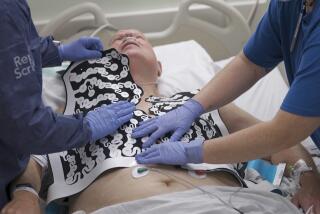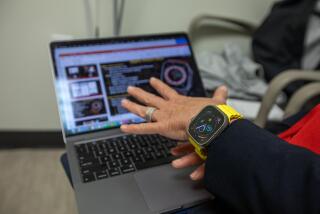On the Ultrafast Track
- Share via
You’re middle-aged, healthy, no signs of any serious illness. Now, suppose you have the chance to undergo a quick, easy, painless test that would show, with a high degree of accuracy, whether you are silently developing heart disease.
It will cost you $400, and you don’t need a doctor’s referral. Any takers?
Not surprisingly, many health-obsessed baby boomers are jumping at the chance for an early warning of the possibility of coronary heart disease. Around Southern California--and the nation--patients are flocking to the growing number of clinics offering a new imaging technology called electron beam computer tomography.
Popularly known by its brand name, Ultrafast CT, the high-tech imaging device improves upon its forerunner, traditional CT. The new test is being touted--and widely advertised--for its ability to identify even the smallest calcium deposits in the arteries that contribute to eventual blockage. The test can identify deposits that would be missed on other types of cardiac tests and that might not even pose a threat unless the disease progressed.
“What this means is that patients who are at risk for coronary artery disease--the No. 1 cause of death in both men and women in America--can now be identified much earlier,” says Dr. Daniel Berman, chief of cardiac imaging at Cedars-Sinai Medical Center. “It’s probably one of the most impressive things that I’ve seen in my career in cardiology.”
Calcium is one component of plaque and is the element responsible for “hardening” of the arteries.
“The scan can detect these deposits long before they are large enough to form an obstruction,” Berman says.
The technology is so highly praised that when word of a study attesting to the scanner’s potential was published in 1997, the stock price of Imatron Inc., a South San Francisco company that is the only maker of the devices, doubled in one day.
Such enthusiasm, however, may be premature, some medical experts say.
The American Heart Assn. and some doctors argue that more studies are needed before the test is routinely recommended for people with no symptoms of heart disease. And, in a recent editorial in the New England Journal of Medicine, two doctors caution that patients should not be referring themselves for the test without consulting a physician.
Aggressive Marketing to Offset Expense
There are about 50 scanners in use around the United States, with local sites including Harbor-UCLA Medical Center, Cedars-Sinai Medical Center and the Healthview Center for Preventive Medicine in Newport Beach. And, to offset the $1-million price tag of the machines, doctors are aggressively marketing the service directly to consumers.
Critics don’t question the benefits of the test, but they think the widespread marketing is premature. The procedure is controversial and poses several questions, including:
* Is it cost-effective compared with traditional, and far cheaper, means of detecting heart disease risk, such as blood pressure monitoring and cholesterol tests?
* Will it encourage people who need not worry about heart disease to waste money undergoing frequent testing? And could it mislead people who have negative tests into thinking they can ignore symptoms of heart trouble?
The test is typically marketed to men over 40 and women over 45 who have at least one risk factor for heart disease. But some centers are using broader criteria, promoting it for men over 35 and people with no reason to suspect heart disease.
“Currently we are facing the possibility that market forces may increase interest in [Ultrafast] CT beyond what is justified by its potential medical benefit,” said Dr. Allen J. Taylor and Dr. Patrick G. O’Malley of the Walter Reed Army Institute of Research in Washington, writing in the Dec. 31 issue of the New England Journal of Medicine.
Because heart disease can be reversed through diet, exercise and medication, researchers have long sought better ways to diagnosis the disease at an early stage. Blood cholesterol tests, blood pressure measurement and exercise treadmill tests are a few of the noninvasive ways to assess heart disease. But the only definitive tests are invasive, expensive and somewhat risky techniques such as angiography, in which a catheter is threaded into the arteries.
Seven Times Faster Than Conventional CT
Ultrafast CT differs from the traditional CT test in that it uses an electron gun with a sweeping motion to collect images. Conventional CT scanners need time to rotate mechanically around the patient, which can blur images due to heart motion. The Ultrafast CT catches the heart between beats while the patient holds his or her breath. The resulting three-dimensional image is produced in one-twentieth of a second--or about seven times faster than conventional CT scan.
“It’s so fast that you get stop-action pictures of the heart. That gives you the clarity,” Berman says.
If the scan shows calcification, which occurs in about 30% of people ages 40 to 50, a treatment plan is recommended, Berman says. If no plaque is found, it is unlikely the patient has coronary artery disease, he says. That doesn’t mean, however, that problems won’t develop later, and so retesting is recommended about every three years.
Perhaps the greatest value of the scan is that it can lead to more appropriate treatment, says Dr. Matthew J. Budoff, co-director of the Electron Beam Computer Tomography Center at Harbor-UCLA Medical Center in Torrance, where research on the Ultrafast CT has gone on for eight years.
For instance, he says, some people with mildly high cholesterol take cholesterol-lowering drugs that cost as much as $600 a year. A scan can show whether a borderline cholesterol level is a real danger.
“I think we can help decide who should be treated and who shouldn’t,” Budoff says. “If they have no calcium at all, they may just need diet and exercise [to lower cholesterol levels]. If they have calcium, they should be on medication.”
For example, when Joyce Rubin turned 50, her doctor advised the Los Angeles woman that it was time to consider taking medication for her hereditary high cholesterol. Rubin, whose parents had suffered from severe atherosclerosis, had tried to control her cholesterol with diet. But when an Ultrafast CT scan performed at Cedars-Sinai showed some calcification, it confirmed the decision to start taking medication.
“The scan reinforced that I’m at risk. But it’s still early enough [in the disease process] that I can take medication and do something about it,” Rubin says.
Studies show the scanner is generally very accurate. In a study in the Dec. 31 New England Journal of Medicine, German researchers compared Ultrafast CT scans with coronary angiography in 125 patients. They found that CT was successful in diagnosing blockages in 92% of cases and was correct in 94% of the negative tests.
But the researchers also found that 25% of the coronary segments could not be evaluated because of inadequate image quality. The patients either couldn’t hold their breath to decrease cardiac motion or technical difficulties prevented clear pictures of some arteries.
Could Eliminate Many Angiographies
Still, the study’s authors estimated that the use of Ultrafast CT could eliminate the need for about two-thirds of angiographies in which no heart disease is found. About 1 million angiograms are performed annually in the United States with about 20% showing no heart disease.
Another benefit of the Ultrafast CT for calcium scanning is that patients with deposits can be followed and tested yearly to see how treatment is working.
“You can cause the calcium to go away with good therapy,” Berman says. “We can track people from year to year to see if they are getting worse or better without putting a needle in the heart.”
But such regular use of the Ultrafast CT scanner is part of what makes some health professionals nervous. They suggest that the technology is ripe for misuse and overuse.
For example, there is no good comparison between the CT scanner and the way heart disease risk has traditionally been calculated (by reviewing family history and through weight, cholesterol and blood pressure measurements), researchers Taylor and O’Malley note.
Although it’s good to urge people with calcium deposits to make changes to improve their health, the editorial warned of creating a group of “worried well” people who seek regular scanning when it really isn’t necessary. Taylor and O’Malley also point out that a positive result will surely lead to additional tests.
“The potential for a gathering snowball of tests--some warranted, some not--is immense,” they wrote.
Finally, they charge that negative tests may be the biggest problem with routine CT scanning. Previous studies have shown that middle-aged and elderly patients with little or no calcification can still have heart attacks or strokes. So, a patient with a negative scan but other symptoms might ignore the symptoms or delay seeking treatment.
Budoff agrees the technology can be misused, citing a doctor who encourages even patients with no calcium deposits to come in for a yearly scan. By advertising the test directly to consumers, Budoff and others say, companies are enticing people who may not need the test to get one anyway.
“I think it has an abuse potential,” he says, noting that his center also uses a marketing company. “Centers need to be very strict in what they let these marketers do. We only scan the high-risk people.”
Scan Candidates Have Risk Factors
Candidates for the scan include people who are healthy but who are at risk of coronary artery disease because they have one or more risk factors, such as diabetes, high blood pressure, a smoking habit, high cholesterol or a family history of heart disease.
The Rev. Curtis May was considered a perfect candidate for screening. He has long worried about his high cholesterol. When his doctor referred him to Harbor-UCLA for a CT scan three years ago, he jumped at the chance to see whether he had heart disease.
“I had a cousin who had a massive heart attack at age 48,” says May, 54, pastor of the Worldwide Church of God in Pasadena. “I got a clean bill of health, and it feels so much better. It feels great to go out there and play sports and not worry.”
Budoff advises that patients seek a referral from their personal doctor, noting that insurance may cover the cost of the test if a doctor prescribes it. Even with a doctor referral, however, insurers may not cover the test.
Many patients say the information is worth the cost of the test. Rubin says it changed her life.
“It made a difference the next time I sat down to eat and the next day when it was time to go running. I can manage my disease in ways I would never have pursued until much later,” she says.
That kind of response is typical, Berman says.
“It is a dramatic motivator,” he says. “Having high cholesterol doesn’t quite sink in the way it does when you show them a picture that demonstrates that they do have coronary artery disease. It’s like meeting your maker. They know what is going to be in store for them.”
(BEGIN TEXT OF INFOBOX / INFOGRAPHIC)
Snapshot of a Danger Within
The new Ultrafast CT scanner allows doctors to see calcium deposits inside blood vessels and make inferences about the amount of blockage that can contribute to heart attacks and strokes. The test can identify heart disease at very early stages.
Stroke: When blood can’t flow to the brain.
Heart attack: A narrowed artery blocks blood flow to the heart.






